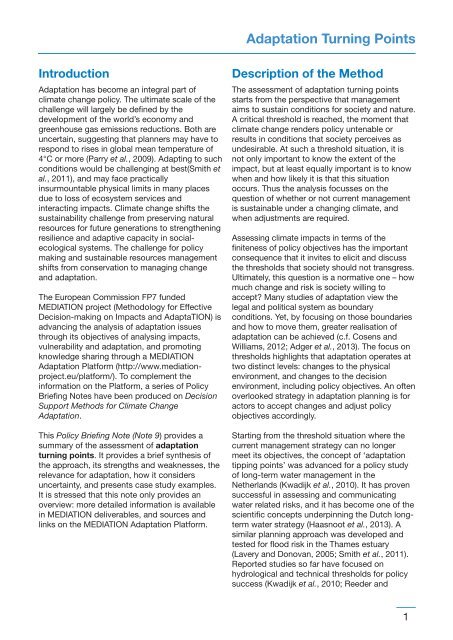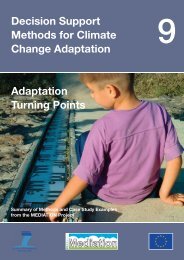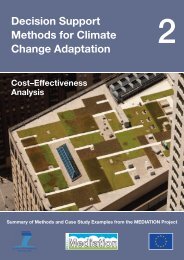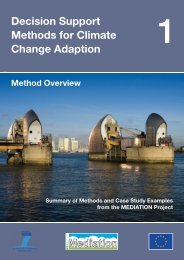Download all Technical Policy Briefing Notes in a single ... - Mediation
Download all Technical Policy Briefing Notes in a single ... - Mediation
Download all Technical Policy Briefing Notes in a single ... - Mediation
- No tags were found...
Create successful ePaper yourself
Turn your PDF publications into a flip-book with our unique Google optimized e-Paper software.
Adaptation Turn<strong>in</strong>g Po<strong>in</strong>tsIntroductionAdaptation has become an <strong>in</strong>tegral part ofclimate change policy. The ultimate scale of thech<strong>all</strong>enge will largely be def<strong>in</strong>ed by thedevelopment of the world’s economy andgreenhouse gas emissions reductions. Both areuncerta<strong>in</strong>, suggest<strong>in</strong>g that planners may have torespond to rises <strong>in</strong> global mean temperature of4°C or more (Parry et al., 2009). Adapt<strong>in</strong>g to suchconditions would be ch<strong>all</strong>eng<strong>in</strong>g at best(Smith etal., 2011), and may face practic<strong>all</strong>y<strong>in</strong>surmountable physical limits <strong>in</strong> many placesdue to loss of ecosystem services and<strong>in</strong>teract<strong>in</strong>g impacts. Climate change shifts thesusta<strong>in</strong>ability ch<strong>all</strong>enge from preserv<strong>in</strong>g naturalresources for future generations to strengthen<strong>in</strong>gresilience and adaptive capacity <strong>in</strong> socialecologicalsystems. The ch<strong>all</strong>enge for policymak<strong>in</strong>g and susta<strong>in</strong>able resources managementshifts from conservation to manag<strong>in</strong>g changeand adaptation.The European Commission FP7 fundedMEDIATION project (Methodology for EffectiveDecision-mak<strong>in</strong>g on Impacts and AdaptaTION) isadvanc<strong>in</strong>g the analysis of adaptation issuesthrough its objectives of analys<strong>in</strong>g impacts,vulnerability and adaptation, and promot<strong>in</strong>gknowledge shar<strong>in</strong>g through a MEDIATIONAdaptation Platform (http://www.mediationproject.eu/platform/).To complement the<strong>in</strong>formation on the Platform, a series of <strong>Policy</strong><strong>Brief<strong>in</strong>g</strong> <strong>Notes</strong> have been produced on DecisionSupport Methods for Climate ChangeAdaptation.This <strong>Policy</strong> <strong>Brief<strong>in</strong>g</strong> Note (Note 9) provides asummary of the assessment of adaptationturn<strong>in</strong>g po<strong>in</strong>ts. It provides a brief synthesis ofthe approach, its strengths and weaknesses, therelevance for adaptation, how it considersuncerta<strong>in</strong>ty, and presents case study examples.It is stressed that this note only provides anoverview: more detailed <strong>in</strong>formation is available<strong>in</strong> MEDIATION deliverables, and sources andl<strong>in</strong>ks on the MEDIATION Adaptation Platform.Description of the MethodThe assessment of adaptation turn<strong>in</strong>g po<strong>in</strong>tsstarts from the perspective that managementaims to susta<strong>in</strong> conditions for society and nature.A critical threshold is reached, the moment thatclimate change renders policy untenable orresults <strong>in</strong> conditions that society perceives asundesirable. At such a threshold situation, it isnot only important to know the extent of theimpact, but at least equ<strong>all</strong>y important is to knowwhen and how likely it is that this situationoccurs. Thus the analysis focusses on thequestion of whether or not current managementis susta<strong>in</strong>able under a chang<strong>in</strong>g climate, andwhen adjustments are required.Assess<strong>in</strong>g climate impacts <strong>in</strong> terms of thef<strong>in</strong>iteness of policy objectives has the importantconsequence that it <strong>in</strong>vites to elicit and discussthe thresholds that society should not transgress.Ultimately, this question is a normative one – howmuch change and risk is society will<strong>in</strong>g toaccept? Many studies of adaptation view thelegal and political system as boundaryconditions. Yet, by focus<strong>in</strong>g on those boundariesand how to move them, greater realisation ofadaptation can be achieved (c.f. Cosens andWilliams, 2012; Adger et al., 2013). The focus onthresholds highlights that adaptation operates attwo dist<strong>in</strong>ct levels: changes to the physicalenvironment, and changes to the decisionenvironment, <strong>in</strong>clud<strong>in</strong>g policy objectives. An oftenoverlooked strategy <strong>in</strong> adaptation plann<strong>in</strong>g is foractors to accept changes and adjust policyobjectives accord<strong>in</strong>gly.Start<strong>in</strong>g from the threshold situation where thecurrent management strategy can no longermeet its objectives, the concept of ‘adaptationtipp<strong>in</strong>g po<strong>in</strong>ts’ was advanced for a policy studyof long-term water management <strong>in</strong> theNetherlands (Kwadijk et al., 2010). It has provensuccessful <strong>in</strong> assess<strong>in</strong>g and communicat<strong>in</strong>gwater related risks, and it has become one of thescientific concepts underp<strong>in</strong>n<strong>in</strong>g the Dutch longtermwater strategy (Haasnoot et al., 2013). Asimilar plann<strong>in</strong>g approach was developed andtested for flood risk <strong>in</strong> the Thames estuary(Lavery and Donovan, 2005; Smith et al., 2011).Reported studies so far have focused onhydrological and technical thresholds for policysuccess (Kwadijk et al., 2010; Reeder and1





